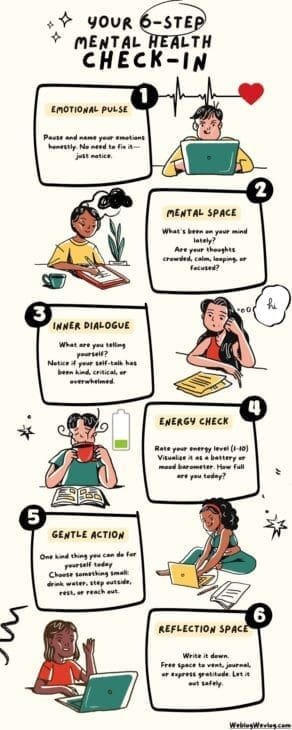Let’s Talk Wellness: A Mental Health Check-In Format

I used to think wellness meant doing everything “right”—eating clean, waking up early, and hitting all my goals like a checklist. But I learned the hard way that none of that matters if you’re mentally checked out. One night, after another week of feeling overwhelmed and numb, I opened a blank journal and tried to write about my week—but the words wouldn’t come. That’s when I realized I needed a structure, a gentle routine to help me process my thoughts and emotions.
Through a bit of trial and error, I created a personal mental health blog format—a place where I could check in with myself without judgment. That’s when wellness finally started to feel real.
This isn’t your typical journal guide. It’s a story, a tool, and a gentle invitation to reconnect with yourself. Whether you’re writing for your growth or sharing your journey with readers, this wellness check-in format might be just what you’ve been missing.
Why Mental Health Check-Ins Became My Wellness Reset
Wellness is such a buzzword these days, but for me, it means being honest with how I’m really doing—emotionally, mentally, and physically. No filters. No pretending.
When I started checking in weekly, I noticed small but powerful changes that actually shifted my day-to-day life. I slept more consistently instead of tossing and turning over anxious thoughts. I noticed fewer moments of panic when deadlines piled up.
My focus at work improved because I was consciously processing my emotions instead of pushing them down. I even started catching early signs of stress—like tension in my shoulders or racing thoughts—before they turned into full-blown overwhelm. I felt more grounded, more aware, and more in charge of my own mental space.
According to the American Psychological Association, nearly 80% of adults say stress affects their physical health. That stat hit home. I was one of them. But this simple habit—this blog-style wellness check-in—helped me take back control in very real ways: I could plan my week with intention, pause when I felt my anxiety rising, and respond to challenges instead of reacting blindly. It wasn’t just a mental shift—it changed how I lived each day.
The Wellness Blog Format That Helped Me Feel Seen
I call it “feeling seen” because, for the first time, I had a structure that validated my emotions instead of letting them get lost in the noise of life. Unlike rigid bullet journals or gratitude-only logs, this mental health blog format is flexible, open-ended, and designed to hold both my triumphs and struggles. It doesn’t demand perfection or productivity—it simply asks: How am I really doing? That distinction is huge.
Over time, this weekly six-step check-in became more than a habit; it became a lens through which I could observe my mental and emotional patterns with clarity, compassion, and real self-awareness. Here’s how each step works and why it matters:

1. Mood Scan: What’s the Weather in Your Head?
I always start by naming what I feel—without sugarcoating. Research by the National Institutes of Health on emotional granularity shows that labeling emotions specifically helps regulate them, reducing emotional reactivity.
Some days, I write a single word: Tense. Other days, a phrase: “Like I’m juggling too many tabs in my brain.” I also check for body signals—clenched jaw, tight shoulders—because our bodies often reveal stress before our minds catch it.
This practice grounds me. It pauses the autopilot, letting me acknowledge what’s really happening instead of burying it.
2. Wins & Wobbles: What’s Working? What’s Not?
Noting wins is obvious, but I’ve learned that reflecting on “wobbles” matters even more. For example, ignoring my inbox didn’t just feel lazy—it led to anxiety, missed opportunities, and a creeping sense of guilt. Tracking these small choices shows how they ripple through my week.
My wins—sticking to my morning walk, making a home-cooked meal, reaching out to a friend—remind me that even small acts of care are powerful mental health boosters. The wobbles, meanwhile, reveal patterns to work on. This balance builds perspective and emotional resilience.
3. Triggers & Triumphs: What Affected Me Most?
This step helps me connect external events and internal reactions. Maybe a casual comment at work triggers a spiral, or a nostalgic song sparks bittersweet emotions. By writing them down, I can see recurring patterns, which research shows improves emotional regulation and reduces impulsive reactions.
Reflecting on what energizes me versus what drains me empowers me to make conscious choices, instead of being tossed around by my own reactions.
4. Needs Check: What Am I Missing Right Now?
Unmet needs are often the hidden fuel for burnout. Here, I ask: Do I need solitude, laughter, movement, or connection? Naming these needs explicitly prevents them from festering silently. Ignoring them can lead to chronic stress, emotional exhaustion, or even physical health decline.
Sometimes my answer is rest. Sometimes, a hug I won’t ask for. Recognizing these needs reinforces self-compassion and supports long-term wellness.
5. Gratitude Snapshot: What’s Still Beautiful?
Gratitude isn’t just fluff—studies from PubMed Central show that regular gratitude journaling improves emotional well-being, sleep, and resilience. Even on hard days, I note small things: a good cup of tea, a stranger’s smile, my cat lying next to me.
This step reminds me that light and struggle can coexist, and that joy doesn’t have to be monumental to matter.
6. Gentle Goal: What’s One Thing I Can Do Next?
Instead of ambitious, overwhelming to-do lists, I choose gentle goals—small, manageable, and nurturing actions. Research in behavioral psychology by the National Institutes of Health shows that achievable goals reduce overwhelm and increase consistency, reinforcing self-efficacy.
Examples: “I’ll take a 10-minute walk tomorrow,” or “I’ll say no to something draining.” These tiny steps build momentum and help me move forward with kindness, rather than pressure.
This six-step wellness blog format isn’t a rigid system. It’s a personal, flexible tool that gives me a safe space to feel seen, process emotions, and grow intentionally. Over time, it has transformed how I relate to myself—turning weekly reflection into a habit of clarity, care, and resilience.
How I Made Wellness a Weekly Habit
Using this blog format every week helped me build a rhythm. Now, my check-ins are part of my Sunday night ritual—a small act of grounding before the week begins.
I make coffee and sit on the porch or in my room. The calm vibe it creates sets the tone for reflection. I use the same six questions every time, which feels comforting and familiar. And I remind myself: You don’t have to be profound.
Why this reminder matters is something I didn’t realize at first. In a world where social media constantly shows polished, curated versions of life, it’s easy to feel pressure to make even private journaling deep, insightful, or “worthy of sharing.” That pressure can make you second-guess your feelings, ignore small but important insights, or avoid writing altogether.
Permitting myself to be honest, imperfect, and human—even when no one else will see it—has been revolutionary for my mental wellness.
Sometimes I post my check-in publicly. Other times, I keep it private. Either way, this practice helps me breathe easier, notice my patterns, and feel more like myself. It’s not about impressing anyone—it’s about showing up for me.
Want a Real-Life Example? Here’s One of Mine:
Sunday Check-In
- Mood: Foggy and fragile
- Wins: Went outside even when I didn’t feel like it, made a warm breakfast, reached out to a friend
- Wobbles: Avoided some hard conversations, procrastinated on a work task
- Trigger: An old photo that brought up a wave of grief
- Need: Permission to reset and be gentle with myself
- Gratitude: A friend who texted “thinking of you” out of the blue
- Gentle Goal: Log off social media for 24 hours
Monday Check-In
- Mood: Tired but slightly hopeful
- Wins: Completed a small work project, did a 10-minute session, drank plenty of water
- Wobbles: Snapped at a coworker, got distracted scrolling social media
- Trigger: An unexpected negative email that sparked self-doubt
- Need: Quiet time to process emotions and regain focus
- Gratitude: My morning coffee and the sunrise through my window
- Gentle Goal: Take a short walk during lunch and practice deep breathing
See how it works? Short, simple, and honest, these entries don’t have to be monumental—they just capture how I really feel and what I need. Having two days side by side also helps me spot patterns: what lifts my mood, what drains me, and where I can intervene gently before stress escalates.
That’s the beauty of this wellness blog format: it’s flexible, reflective, and completely tailored to your life. It doesn’t have to be perfect, but it does give you a snapshot of your week, your emotions, and your needs—a roadmap for emotional self-care.
FAQs
1. How often should I do this wellness check-in?
You can do it weekly, like I do, or adjust it to fit your routine—daily, biweekly, or whenever you feel the need. The key is consistency over frequency. Even short check-ins help you notice patterns, process emotions, and stay connected to yourself.
2. Do I have to share my check-ins publicly?
Absolutely not. This is your space. Some weeks I post mine, some weeks I keep it private. The goal isn’t to impress anyone—it’s to be honest with yourself and create a habit that supports your emotional well-being.
3. What if I feel nothing or can’t put words to my emotions?
That’s completely normal. Sometimes your mind or body just needs to pause. You can start with simple observations: “Tired,” “tense,” or “restless.” Even naming small feelings or physical sensations counts as a check-in. Over time, this builds emotional awareness and makes it easier to articulate your deeper needs.
So…How Are You Doing? Let’s Check In Together
If no one’s asked you that lately, let me be the first: How are you, truly?
You don’t need to write a masterpiece. You just need to pause, breathe, and check in. Wellness begins with awareness—and a little bit of courage.
To make it easier, I’ve created a mini journaling prompt sheet based on this blog format. It includes Mood Scan, Wins & Wobbles, Triggers & Triumphs, Needs Check, Gratitude, and Gentle Goal prompts—everything you need to get started, whether you write in a notebook, your phone, or a private blog.
Try it today. Write it down. Say it out loud. Post it or keep it sacred. However you use it, make it yours.
If you want, share your “Mood Scan” or “Gentle Goal” in the comments. I’ll read it. I’ll root for you. You don’t have to navigate your emotions alone. This is a small, practical step toward feeling seen, grounded, and more connected to yourself.


